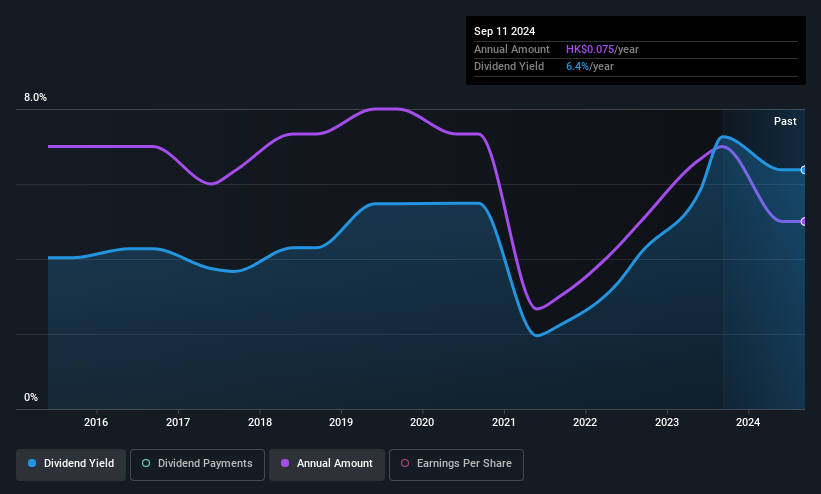Tan Chong International Limited (HKG:693) Is About To Go Ex-Dividend, And It Pays A 6.8% Yield
Tan Chong International Limited (HKG:693) stock is about to trade ex-dividend in three days. The ex-dividend date is usually set to be two business days before the record date, which is the cut-off date on which you must be present on the company's books as a shareholder in order to receive the dividend. It is important to be aware of the ex-dividend date because any trade on the stock needs to have been settled on or before the record date. Meaning, you will need to purchase Tan Chong International's shares before the 30th of May to receive the dividend, which will be paid on the 26th of June.
The company's upcoming dividend is HK$0.055 a share, following on from the last 12 months, when the company distributed a total of HK$0.075 per share to shareholders. Based on the last year's worth of payments, Tan Chong International stock has a trailing yield of around 6.8% on the current share price of HK$1.11. Dividends are a major contributor to investment returns for long term holders, but only if the dividend continues to be paid. We need to see whether the dividend is covered by earnings and if it's growing.
We've discovered 3 warning signs about Tan Chong International. View them for free.Dividends are usually paid out of company profits, so if a company pays out more than it earned then its dividend is usually at greater risk of being cut. That's why it's good to see Tan Chong International paying out a modest 32% of its earnings. A useful secondary check can be to evaluate whether Tan Chong International generated enough free cash flow to afford its dividend. The company paid out 103% of its free cash flow over the last year, which we think is outside the ideal range for most businesses. Cash flows are usually much more volatile than earnings, so this could be a temporary effect - but we'd generally want to look more closely here.
While Tan Chong International's dividends were covered by the company's reported profits, cash is somewhat more important, so it's not great to see that the company didn't generate enough cash to pay its dividend. Cash is king, as they say, and were Tan Chong International to repeatedly pay dividends that aren't well covered by cashflow, we would consider this a warning sign.
View our latest analysis for Tan Chong International
Click here to see how much of its profit Tan Chong International paid out over the last 12 months.

Have Earnings And Dividends Been Growing?
Businesses with strong growth prospects usually make the best dividend payers, because it's easier to grow dividends when earnings per share are improving. If earnings decline and the company is forced to cut its dividend, investors could watch the value of their investment go up in smoke. Fortunately for readers, Tan Chong International's earnings per share have been growing at 18% a year for the past five years. Earnings have been growing at a decent rate, but we're concerned dividend payments consumed most of the company's cash flow over the past year.
Many investors will assess a company's dividend performance by evaluating how much the dividend payments have changed over time. Tan Chong International's dividend payments per share have declined at 3.3% per year on average over the past 10 years, which is uninspiring. It's unusual to see earnings per share increasing at the same time as dividends per share have been in decline. We'd hope it's because the company is reinvesting heavily in its business, but it could also suggest business is lumpy.
The Bottom Line
From a dividend perspective, should investors buy or avoid Tan Chong International? We like that Tan Chong International has been successfully growing its earnings per share at a nice rate and reinvesting most of its profits in the business. However, we note the high cashflow payout ratio with some concern. In summary, it's hard to get excited about Tan Chong International from a dividend perspective.
While it's tempting to invest in Tan Chong International for the dividends alone, you should always be mindful of the risks involved. For example, Tan Chong International has 3 warning signs (and 1 which doesn't sit too well with us) we think you should know about.
Generally, we wouldn't recommend just buying the first dividend stock you see. Here's a curated list of interesting stocks that are strong dividend payers.
Have feedback on this article? Concerned about the content? Get in touch with us directly. Alternatively, email editorial-team (at) simplywallst.com.
This article by Simply Wall St is general in nature. We provide commentary based on historical data and analyst forecasts only using an unbiased methodology and our articles are not intended to be financial advice. It does not constitute a recommendation to buy or sell any stock, and does not take account of your objectives, or your financial situation. We aim to bring you long-term focused analysis driven by fundamental data. Note that our analysis may not factor in the latest price-sensitive company announcements or qualitative material. Simply Wall St has no position in any stocks mentioned.
① During the campaign period, US stocks, US stocks short selling, US stock options, Hong Kong stocks, and A-shares trading will maintain at $0 commission, and no subscription/redemption fees for mutual fund transactions. $0 fee offer has a time limit, until further notice. For more information, please visit: https://www.webull.hk/pricing
Webull Securities Limited is licensed with the Securities and Futures Commission of Hong Kong (CE No. BNG700) for carrying out Type 1 License for Dealing in Securities, Type 2 License for Dealing in Futures Contracts and Type 4 License for Advising on Securities.

English